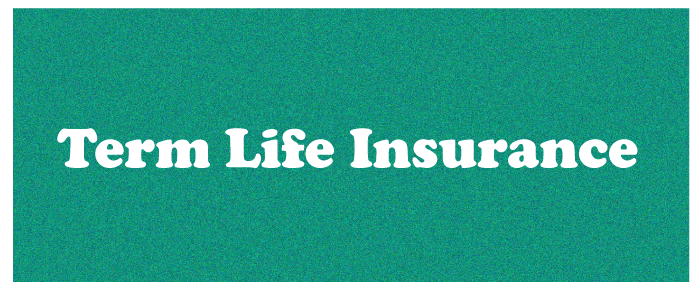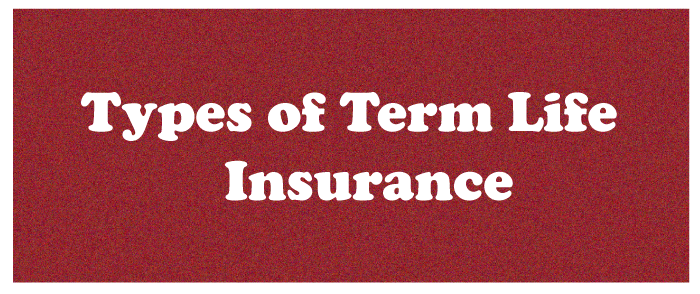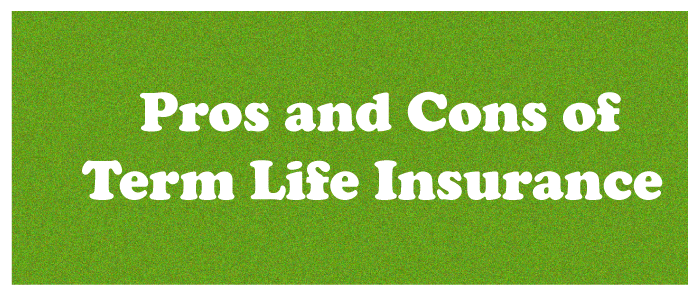Term Life Insurance: What It Is, Different Types, Pros and ConsTerm life insurance is also known as the simplest and purest form of life insurance. One pays a premium for a predetermined period of time, typically between 10 to 30 years. If the insured person passes away within the policy period, the respective family of the insured person receives a cash payout (or anyone else he/ she has named as the beneficiary). However, there are many terms and conditions based on a person's age, health and many other factors. 
Although term life insurance is generally available at a lower cost than permanent whole life insurance, these term life policies do not have cash values, such as no payouts after the term period ends, or any value other than the death benefit, unlike permanent life insurance. Most term life insurance policies are "level premium", meaning that the monthly premium does not change during the policy's entire term. The price of term life insurance is influenced by several variables, including age, health, and life expectancy. How does a Term Life Insurance work?At its most basic form, a term life insurance policy is an agreement between both the person who purchases it (the policyholder) and an agent from the insurance provider company. The holder agrees to pay a premium for a set period (often between 10 and 30 years); in exchange, the provider guarantees to pay a specific death benefit in cash to somebody (the beneficiary) upon the insured person's passing. Typically, that benefit is also tax-free. The premium for term life insurance is established by the insurance provider depending on the buyer's gender, age, and health, as well as the policy's value (the payout amount). Occasionally, a medical examination may be required by the insurer for the person who is applying for the term life insurance. The insurance provider might also ask about the person's driving history, current medications, whether he/she smokes, what he does for a living, his interests, family background, and other details. The insurer will give the beneficiaries the face value of the policy if they pass away while the policy is still in force. If the coverage ends prior to their death, there will be no payout. However, the insurer can always renew a term policy when it expires. However, the premiums would be recalculated depending on his age at that time. Types of Term Life Insurance
There are multiple different types of term life insurance. One should choose the appropriate course of action depending on the specific situation. Some notable term life insurance includes the followings: Level-Premium PolicyAlso known as the level term, this is the most basic and typical kind of coverage. Generally, the premium is the same during the entire term of this policy. The premium and death benefit are both predetermined (Fixed). These insurance policies provide protection for a period of 10 to 30 years. Since actuaries are required to consider the increasing costs of insurance during the length of the policy's effectiveness, the premium is comparatively higher in this policy than in yearly renewable term life insurance. Yearly Renewable Term (YRT) Policy Annually or yearly renewable term (YRT) policies are those that renew each year without requiring proof of insurability. They do not have a set timeframe. The premiums increase each year as the insured person ages. Although the coverage has no set term, the premiums may become expensive as the insured ages with time. Decreasing Term Policy These plans' death benefits decline yearly in accordance with a predetermined plan. However, the insured pays a steady, flat premium throughout the insurance term. Term policies with decreasing payouts are frequently used in conjunction with mortgages, with the policyholder aligning the insurance payout with the loan's decreasing principal. Simply put, as the age increases, the policy benefits decrease. Return of Premium PolicyThis is a specific type of term life insurance. If someone lives to the end of the policy's term, this sort of policy pays all or some of the premium payments. Unlike level-term insurance, these policies have a maturity benefit that returns the full premium paid to the life insured if they live through the policy's expiration. Increasing Term PolicyIn these policies, the insured has the option to keep the premium amount constant while increasing the sum assured on a yearly basis throughout the policy term. Because of this, the premium for these policies is a little bit greater than it would be for level-term insurance. However, the benefits increase in accordance with age over time. Convertible Term PolicyThese plans have a conversion feature that allows the policyholder to change their current policy into any other kind of plan later. For instance, suppose a person purchases this term insurance plan for 20 years; they can easily convert it even after just five years into an endowment plan, whole life insurance plan, etc. This policy plan is mainly helpful for those who are not sure about choosing the right plan while buying a term life insurance policy. Pros and Cons of the Term Insurance
ProsThe insured is provided security and life coverage under the term insurance plans. In addition to this major benefit, the term insurance plan also has the following significant benefits: Premiums and Payouts One of the advantages of a term plan is that one may choose how they want to pay their premiums: all at once, for a limited time, or on a regular basis (like monthly, quarterly, etc.). Similar to payouts, one might get payment in the form of a lump sum or a fixed amount each month. Cost Effective Term insurance is less expensive than other long-term insurance options. It is one of the primary reasons why most people choose term insurance. This is due to the fact that this plan's premiums are significantly lower, but the cover or sum assured is bigger. Convertibility and Renewability Flexibility is a key advantage of term plans, among many others. Plans that can be later turned into long-term insurance policies are available to buy. One can lengthen the duration of the insurance while keeping the amount assured the same. When their current term of coverage expires, one can acquire insurance that can be renewed to extend the period of coverage. This is especially helpful because, even if they outlive the term, one won't lose out on the premiums they paid. Tax Benefits The insured receives a tax benefit from the term insurance plans that various life insurance firms offer. The income tax advantages of term insurance are similar to those offered by long-term insurance products. ConsHowever, the term insurance plan also has some disadvantages. Some of the notable drawbacks are mentioned below: Specific T&Cs Term plans do not include an investment component compared to other long-term insurance packages. Rather, it is a pure protection policy that does not enable the buyer to receive refunds while they are still alive. The benefits are only given to the beneficiary of the insured after he/she passes away. No Financial Value There will never be any financial value from the term plan. One can never anticipate a financial value for the premium money they have already paid. Non-profit Investments Term plans are considered non-profit investments. They may only need the individual to make premium payments until the term plan expires or the policyholder passes. In the second case, the death benefit will be paid to the nominee or family members. So, even the benefits are definitely not sure. High Premium If a person purchases a term plan later in life, they would be required to pay a high premium for a bigger sum, which is unaffordable for many. While some people may need a big sum assured, they may not be able to pay a greater premium in their older age time. In these circumstances, the person is either compelled to bear an additional financial strain to pay a premium larger than what they budgeted or to reduce the amount assured.
Next TopicThe Top 25 Economies in the World
|
 For Videos Join Our Youtube Channel: Join Now
For Videos Join Our Youtube Channel: Join Now
Feedback
- Send your Feedback to [email protected]
Help Others, Please Share









